英语语言学课件(胡壮麟版)
- 格式:ppt
- 大小:8.01 MB
- 文档页数:91

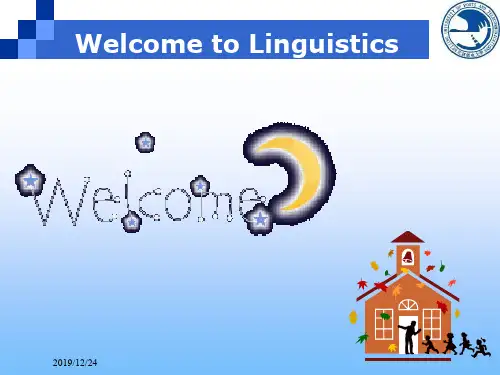
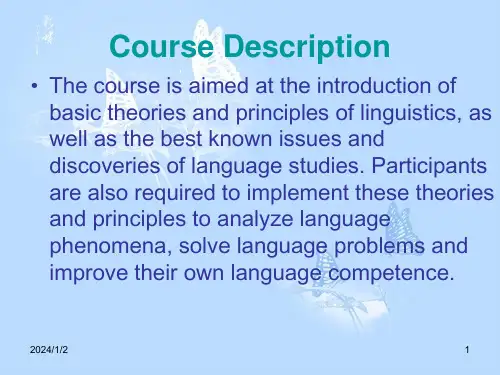
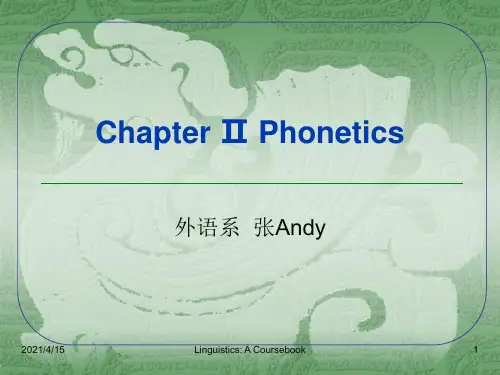
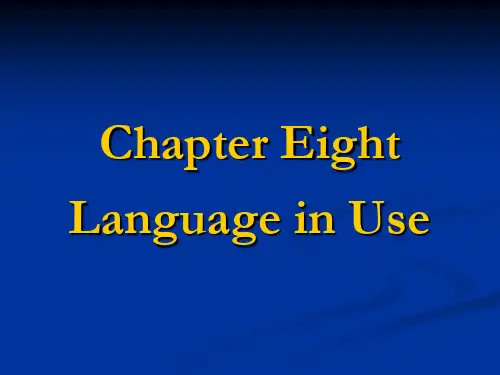
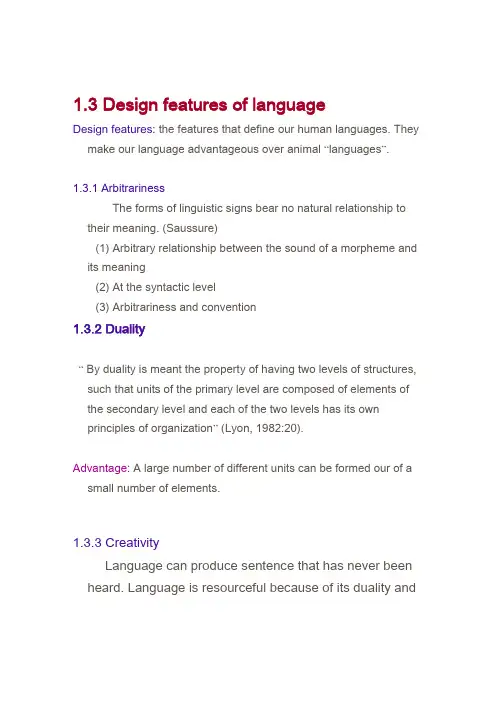
1.3 Design features of languageDesign features: the features that define our human languages. They make our language advantageous over animal “languages”.1.3.1 ArbitrarinessThe forms of linguistic signs bear no natural relationship to their meaning. (Saussure)(1) Arbitrary relationship between the sound of a morpheme andits meaning(2) At the syntactic level(3) Arbitrariness and convention1.3.2 Duality“ By duality is meant the property of having two levels of structures, such that units of the primary level are composed of elements of the secondary level and each of the two levels has its ownprinciples of organization” (Lyon, 1982:20).Advantage: A large number of different units can be formed our of a small number of elements.1.3.3 CreativityLanguage can produce sentence that has never been heard. Language is resourceful because of its duality andrecursiveness.1.3.4 DisplacementHuman languages enable their users to symbolize objects, events and concepts which are not present ( in time and space) at the moment of communication.Other design featuresCultural transmissionLanguage is passed down from generation to generation. Human being must be exposed to language environment.InterchangeabilityAny human being can be both a producer and receiver of the message.1.4 Origin of languageThe bow-wow theoryThe pooh-pooh theoryThe “yo-he-ho” theory1.5 Functions of language1.5.1 Informative1.5.2 Interpersonal function1.5.3 Performative1.5.4 Emotive function1.5.5 Phatic communion1.5.6 Recreational function1.5.7 Metalingual function1.6 What is linguistics?Linguistics is the scientific study of language.1.7 Main branches of linguistics1.7.1 PhoneticsPhonetics is the subfield of linguistics that studies speech sounds in human language.Major domains: Articulatory phonetics, Acoustic phonetics, Auditory phonetics1.7.2 Phonology-Phonology is the subfield of linguistics that studies the sound pattern of a language. -It deals with the rules governing the structure,distribution and sequencing of speech sounds and the shape of syllables.-Phonetics vs. PhonologyPhonetics is the study of speech sounds that the human voice is capable of creating whereas phonology is the study of a subset of those sounds that constitute language and meaning. The first focus on chaos while the second focuses on order.1.7.3 MorphologyMorphology is the subfield of linguistics that studies the internal structure of words and the relationships among words.1.7.4 SyntaxSyntax is the subfield of linguistics that studies the internal structure of sentences and the relationships among the internal parts.1.7.5 SemanticsSemantics is the subfield of linguistics that studies the nature of the meaning of individual words, and the meaning of wordsgrouped into phrases and sentences.1.7.6 PragmaticsPragmatics is the subfield of linguistics that studies the use of words, phrases and sentences in the actual context of discourse.1.8 Macrolinguistics1.8.1 PsycholinguisticsPsycholinguistics studies the relationship between language and mind. It also studies language development in the child, biological foundations of language and the relationship between language and cognition.1.8.2 SociolinguisticsSociolinguistics is the study of characteristics of language varieties, the characteristics of their functions, and thecharacteristics of their speakers.1.8.3 Anthropological linguisticsAnthropological linguistics is the study of the history and structure of formerly unwritten languages. They are concerned with the emergence and divergence of languages over thousands of years.1.8.4 Computational linguisticsComputational linguistics is an interdisciplinary field which centers around the use of computers to process or produce human language.1.9 Important distinctions in linguistics1.9.1 Descriptive vs. prescriptive-Descriptive (non-normative): to describe what people say. “… the linguist tries to discover and record the rules to which the members of a language-community actually conform and does not seek to impose upon them other rules, or norms, of correctness.” (Lyon, 1982:47)-Prescriptive: to prescribe how people should say. In the 18th century, the grammarians tried to lay down rules for the correct use oflanguage and settle the disputes over usage once and for all.1.9.2 Synchronic vs. diachronic-Synchronic linguistics is the study of a given language at a given period of time. E.g. “A Grammar of Modern Greek”-Diachronic linguistics is the study of the changes the language has experienced.1.9.3 Langue & parole (Saussure)-Langue is the abstract linguistic form or system shared by all the members of a speech community. It is a social product. It is a set of convention.-Parole is the actual or actualized language. It is the concrete use of the conventions or application of the rules.1.9.4 Competence and performance (Chomsky)-Competence refers to the ideal language speaker’s underlying knowledge about the system of rules.-Performance refers to the actual use of language by the speaker in concrete situation.1.9.5 Etic vs. Emic (Pike)Questions and ExercisesDo you think that onomatopoeia indicates a non-arbitrary relationship between form and meaning?Does the traffic light system have duality, why?Communication can take many forms, such as sign, speech, body language and facial expression. Do body language and facial expressionshare or lack the distinctive properties of human language?Can you mention some typical expressions of phatic communion in Chinese?。
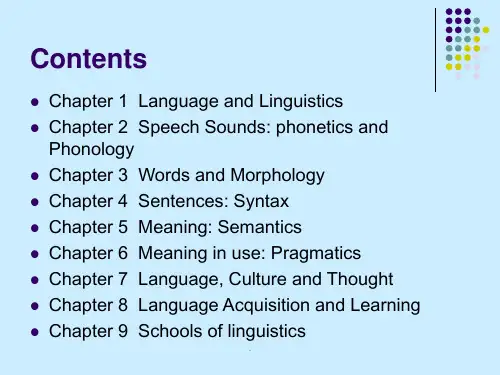
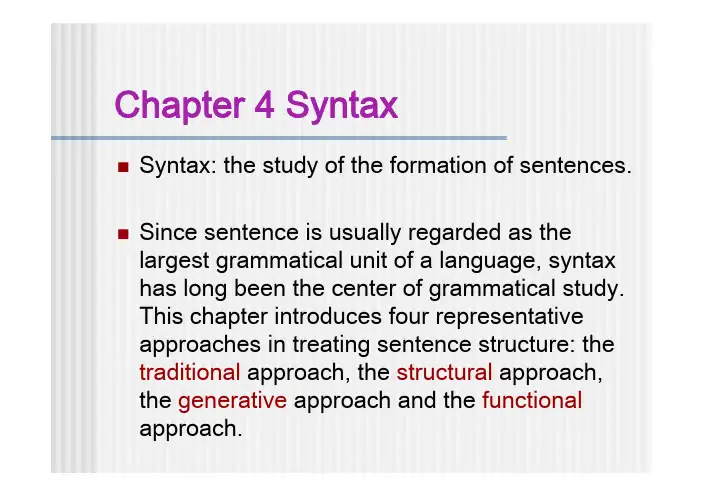
Chapter 4 SyntaxSyntax: the study of the formation of sentences. Since sentence is usually regarded as the largest grammatical unit of a language, syntax has long been the center of grammatical study. This chapter introduces four representative approaches in treating sentence structure: the traditional approach, the structural approach, the generative approach and the functional approach.4.1 The traditional approach4.1.1 Number, gender and caseNumber: singular and pluralCase:1)Pronouns: nominative(I, he, she), accusative(me, him,her), genetive(my, your, his)2)Nouns: general(John, boy), genitive(John’s, boys’)4.1.2 Tense and aspectTenses: past and presentAspect: perfective(perfect) and progressive(continuous)4.1.3 Concord and governmentConcord(Agreement) is the requirement that the forms of two or more words in a syntactic relationship should agree with each other in terms of some categories. Eg. this man, these men; a book, some booksGovernment is another type of control the form of some words by other words in certain syntactic constructions. It differs from concord in that this is a relationship in which a word of a certain class determines the form of others in terms of certain category.Eg. She gave him a book. She gave a book to him.4.2 The structural approach4.2.1 Syntagmatic and paradigmatic relations (Saussure) -Signified(concept) and signifier (sound image)-Syntagmatic relation(structure, horizontal relation,chain relation):the relation between one item and others in a sequence-Paradigmatic relation(system, vertical relation, choicerelation): the relation between elements replaceable with each other at a particular place in a structure, or between one element present and the others absent.4.2.2 Immediate constituent analysis(IC analysis)-construction and constituents(Bloomfield)-immediate constituents-ultimate constituents-IC analysis:the analysis of a sentence in terms of its immediate constituents---word groups (or phrases), which are in turn analyzed into the immediate constituents of their own, and the process goes on until the ultimate constituents are reached.ex.1 (a) ( ( Poor) (John) ) ( ( ran) ( away) )(b) Poor John ran awayex.2 John left yesterdayex.3 dis place mentAdvantage:Through IC analysis, the internal structure of a sentence may be demonstrated clearly, and ambiguities will be revealed.Ex. 1.(a) Leave the book on the shelf(b) Leave the book on the shelf(b) my small child’s cot(c) my small child’s cotEx.3(a) The son of Pharaoh’s daughter is the daughter of Pharaoh’s son(b) The son of Pharaoh’s daughter is the daughter of Pharaoh’s sonEx.4(Labelled tree diagram)more expensive clothes more expensive clothes Adj Adj N Adv Adj NNP APNP NPEx.5(Is he really) that kind? (Is he really) that kind?Det N Adv AdjNP APEX.6They can fish herePron Aux V AdvPron V N Adv-Problems:1) Binary division ? Old men and women2) Discontinuous constituents ? make it up4.2.3 Endocentric and exocentric constructions-Endocentric construction(headed construction) is a construction whose distribution isfunctionally equivalent, or approachingequivalence, to one of its constituents, whichserve as the center/head of the whole.e.g. poor John, the three small children1) Subordinate construction:only one head (e.g.really very late, the book on the shelf, walked away immediately)2) Coordinate construction:more than one head(e.g.boys and girls, coffee or tea, the city Rome)-Exocentric construction is a construction whose distribution is not functionally equivalent to any of its constituents.e.g.Prepositional phrases :on the shelf, if he is goingBasic sentences :The girl smiled.? Verb plus object constructions :visit Bill, read books。
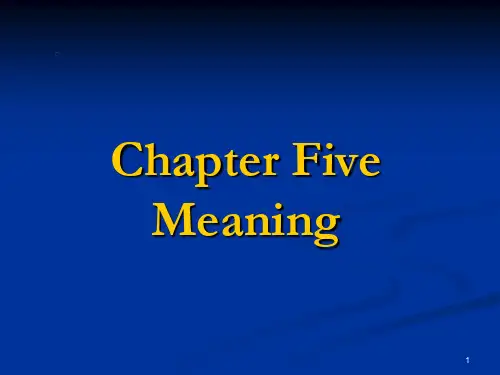


Chapter 5 Meaning Semantics:the study of the meaning of linguistic units, words and sentences in particular.5.1 Meanings of “meaning”7 types of meaning(Leech):1. Conceptual meaning: Logical, cognitive, ordenotative contentAssociate meaning:2. Connotative meaning:What is communicatedby virtue of what language refers to.3. Social meaning:What is communicated of thesocial circumstances of language use.4. Affective meaning: What is communicated ofthe feelings and attitudes of thespeaker/writer.5. Reflected meaning: What is communicatedthrough association with another sense ofthe same expression.6. Collocative meaning: What is communicatedthrough association with words which tendto occur in the environment of another word.7.Thematic meaning: What is communicatedby the way in which the message isorganized in terms of order and emphasis.-Connotation and denotation5.2 The referential theory-The theory of meaning which relates the meaning of a word to the thing it refers to, or stands for, is known as the referential theory.-Semantic triangle(Ogden and Richards):conceptword thing-Sense and reference5.3 Sense relationsSense: the semantic relations between one word and another, or more generallybetween one linguistic unit and another.3 kinds of sense relations:1)Sameness relation---Synonymy2)Oppositeness relation---Antonymy3)Inclusiveness relation---Hyponymy5.3.1 Synonymy1)Differ in style: buy and purchase2) Differ in connotations: thrifty, economicaland stingy3) Dialectual difference: autumn and fall, flatand apartment, underground and tube5.3.2 Antonymy1) Gradable antonymy: good-bad, long-short, big-small, hot-cold, warm-cool“Marked”(unusual)and “Unmarked”(the cover term, unusual, e.g. old)2) Complementary antonymy:alive-dead, male-female,present-absent, pass-fail (a test),odd-even, hit-miss (a target), boy-girl3) Converse antonymy(Relational opposite): buy-sell, lend-borrow, give-receive, before-after, husband-wife, host-guest, employee-employer5.3.3 Hyponymy Hyponyms: the members, the lower termsCo-hyponyms: members of the same classSuperordinate:the name of a classA superordinate may be missing. Hyponyms may also be missing.Ex. livingplant animalbird fish insect animalhuman animaltiger lion elephant …5.4 Componential analysis Componential analysis refers to an approach by structural semantics in describing the meaning of words.It aims at breaking down the meaning of a word into its minimal distinctive features which are also called components.E.g. the meaning of the word boy may be analyzed into three components: HUMAN, YOUNG and MALE. Girl may be analyzed into HUMAN, YOUNG and FEMALE; man into HUMAN, ADULT and MALE, and woman into HUMAN, ADULT and FEMALE.5.5 Sentence meaning5.5.1 An integrated theoryThe principle of compositionality: the meaning of a sentence depends on the meanings of the constituent words and the way they are combined.A semantic theory consists of two parts(Katz and Postal): a grammantical classification and semantic rules.Grammatical/Syntactic markers Semantic markers DistinguishersSelection restrictions Problems5.5.2 Logical semantics Propositional logic( propositional calculus or sentential calculus) is the study of the truth conditions for propositions: how the truth of a composite proposition is determined by the truth value of its constituent propositions and the connections between them.“A proposition is what is expressed by a declarative sentence when that sentence is uttered to make a statement.”(J.Lyons)Predicate logic( predicate calculus) studies the internal structure of simple propositions.Argument and predicateAn argument is a term which refers to some entity about which a statement is being made.A predicate is a term which ascribes some property, or relation, to the entity, or entities, referred to. In terms of the number of arguments it takes, it can be classified into: one-place predicate: Socrates is a man.two-place predicate:John loves Mary.three-place predicate: John gave Mary a book.Questions and Exercises Some people maintain that there are no truesynonyms. If two words mean really the same, one of them will definitely die out. Do you agree? In general what type of meaning we are talking about when we say two words are synonymous with each other?Consider the following antonyms: friendly:unfriendly, honest: dishonest, normal: abnormal, logical: illogical.Which type of antonymy do they belong to?Comment on F.R.Palmer’s following argument: “…We can treat male/female, married/single, alive/dead as gradable antonyms on occasions. Someone can be very male or more married and certainly more dead than alive.”Which type of antonymy do the following antonyms belong to? Bigger:smaller, longer:shorter, better: worse, older: younger.姜望琪(1991:79)claims that “To some extent, we can say that any two words of the same part of speech may become antonyms, as long as the meaning difference between them is what needs to be emphasized in the particular context.”He uses the two sentences below as examples. What do you think of the claim?You have to peel a raw potato but you can skin a boiled one. He’s no statesman, but a mere politician.。
胡壮麟语言学课件Chapter OneInvitations to Linguistics1.1 Why Study LanguageLanguageFeaturesFunctionLanguage learningfirst language leaningsecond language learning1.2 What Is LanguageLanguage is a system of arbitrary vocal symbols used for human communication.System: elements in language are arranged according to certain rules.Arbitrary: There is no intrinsic connection between the word and its meaning.Symbolic nature of language: words are associated with objects, actions, ideas by convention.1.3 Design Features of LanguageDesign features are features that define our human language.Design Features of Language(1)Arbitrariness: the fact that the forms of linguistic signs bear no natural relationship to their meaning.arbitrariness at different levels of a language1) arbitrary relationship between the sound of a morpheme and its meaning2) arbitrariness at the syntactic levelapples, pears and bananaspears, apples and bananasb) He came in and sat down.He sat down and came in.He sat down after he came in.c) She got married and had a baby.She had a baby and got married.d) 屡战屡败屡败屡战3) arbitrariness and conventionarbitrariness→ language creativeconvention→ learnabili ty;→ learning a language laborious1.3 Design Features of Language(2)Duality: the property of having two levels of structures1) sound— secondary units2) meaning — primary units1.3 Design Features of Language(3)Creativity(productivity): Users can understand and produce sentences they have never heard before.1) Words can be used in new ways to mean new things.mouse bridge2) Its potential to create endless sentences by recursiveness (递归性)e.g. a. Smith believes that the earth is flatb. Brown believes that Smith believes that the earth is flatc. Smith believes that Brown believes that Smith believes that the earth is flatd. Brown believes Smith believes that Brown believes thatSmith believes that the earth is flat山里有座庙,庙里有个和尚,老和尚在念经,念的什么经:山里有座庙,庙里有个和尚,老和尚在念经,念的什么经:山里有座庙,庙里有个和尚,老和尚在念经,念的什么经……1.3 Design Features of Language(4)Displacement means that human languages enable their users to symbolize objects, events and concepts which are not present (in time or space) at the moment of communication.1.3 Design Features of Language(5)Cultural transmission: language is passed on through teaching and learning, rather than by instinct.1.4 Origin of LanguageThe bow-wow theory汪汪理论: imitate the sounds of the animals. onomatopoeicThe pooh-pooh theory噗噗理论: instinctive sounds of pain, anger and joy. interjectionThe yo-he-ho theory哟嗬哟理论: rhythmic grunts produced when working . chantsOrigin of LanguageThe divine-origin theory“So he (God) took some soil from the ground and formed all the animals and all the birds. Then he brought them to the man to see what he would name them, and that is how they got their names. So the man named all the birds and the animals,…”(Genesis,Chapter11:6)The invention theorya. imitativeb. cries of naturec. grunts of men working togetherThe evolution theory1.5 Functions of Language(1)Jakobson"Linguistics and Poetics: Closing Statement"All acts of communication, be they written or oral, are contingent on six constituent elements: context, message, addresser, addressee, contact and codeEach of the constituent elements of the communicative act has a corresponding function; thus:referential,poetic,emotive,phatic, conative and metalingualcontextREFERENTIALAddresser message addresseeEMOTIVE POETIC CONA TIVEcontactPHA TICcodeMETALINGUALReferential : to convey message and informationEmotive: to express attitudes, feelings and emotionsPoetic: to indulge in language for its own sakeConative: to persuade and influence others through commands and requestsPhatic: to establish communion with othersMetalingual: to clear up intentions and meanings1.5 Functions of Language(2)Halliday: three metafunctions of language:1) ide ational function is to organize the speaker’s or the writer’s experience of the real or imaginary world, i. e. language refers to real or imagined persons,things actions,events,states,etc.达意功能指组织说话者或作者现实或虚构世界的体验,即语言指称实际或虚构的人、物、动作、事件、状态等。
2. What is this course about?Chapter 1 Invitations to LinguisticsChapter 2 Speech SoundsChapter 3 LexiconChapter 4 SyntaxChapter 5 MeaningChapter 6 Language and cognitionChapter 7 Language, Culture, and SocietyChapter 8 Language in useChapter 9 language and literatureChapter 10 language and computerChapter 11 linguistics and foreign language teachingChapter 12 Theories and schools of modern linguistics1. languageDefinitionFeaturesFunctions1) Definition:Sapir, 1921: Language is a purely human and non-instinctive method of communicating ideas, emotions and desires by means of voluntarily produced symbols.(语言是纯粹人为的、非本能的、用任意制造出来的符号系统来传达观念、情绪和欲望的方法。
)Hall, 1968: Language is "the institution whereby humans communicate and interact with each other by means of habitually used oral-auditory arbitrary symbols." (语言是人们通过惯用的任意性的口头-听觉符号进行交际和互动的惯例。
胡壮麟语言学教程课件Part11Chapter 8 Language in Use 8.1 Speech Act TheoryPerformatives and constativesA Theory of Illocutionary Act8.2 The Theory of conversational Implicature The Cooperative PrincipleViolation of the maximsCharacteristics of Implicature8.3 Post-Gricean DevelopmentRelevance TheoryThe Q-and R-PrinciplesThe Q-,I-and M-Principles8.1 Speech Act TheoryThis is the major theory in the study of language in use, which originated with J.L.Austin.8.1.1 Performatives and ConstativesAustin in his How to Do Things with Words claims that there are two types of sentences: Performatives and constatives.1)Performatives are utterances by which a speaker does something.2) Constatives are sentences by which a speaker makes a statement that may be trueor false.Felicity Conditions have to be met for performatives to be appropriate or felicitous.8.1.2 A Theory of the Illocutionary ActIn Austin’s opinion, there are three senses in which saying something maybe understood as doing something.1) Locutionary Act: the act of producing some units of language with certain meanings.2) Illocutionary Act: the act of producing some units of language with the intention of thespeaker.3) Perlocutionary Act:the act which is performed through, by means of , a locutionaryact.8.2 The Theory of Conversational Implicature The second major theory of pragmatics is the theory of conversational Implicature, proposed by Paul Grice.8.2.1 The cooperative principle (CP)To specify the CP further, Grice introduced four categories of maxims as follows:1) Quantityi) make your contribution as informative as is required (for the current purpose ofthe exchange).ii) do not make your contribution more informative than is required.2) QualityTry to make your contribution one that is true.i) do not say that you believe to be false.ii) do not say that for which you lack adequate evidence.3) RelationBe relevant4) MannerBe perspicuousi) avoid obscurity of expression.ii) avoid ambiguity.iii) be brief.iv) be orderly.The cooperative principle and its component maxims are descriptive, rather than prescriptive.8.2.2 Violation of the Maxims8.2.3 Characteristics of Implicature1) Calculability2) cancellability3) Non-detachability4) Non-conventionalityConversational Implicature is a type of implied meaning, which is deduced on the basis of the conventionalmeaning of words together with the context, under the guidance of the CP and its maxims.8.3 Post-Grice Developments8.3.1 Relevance TheoryThis theory is formally proposed by Dan Sperser and Deirdre Wilson in their book Relevance: Communication and Cognition in 1986.The principle of relevance is defined as:Every act of ostensive communication communicates the presumption of its own optimal relevance.8.3.2 The Q-and R-PrincipleThese two principles are developed by Laurence Horn.1) The Q-principle ( Hearer-based)2) The R-principle ( Speaker-based)8.3.3 The Q-, I-and M-principle1) Q-principle2) I-principle3) M-principleQuestions1 Consider the following dialogue between a man and his daughter. Tryto explain the illocutionary force In each of the utterance.[ the daughter walks into the kitchen and takes some popcorn]Father: I thought you were practicing your violin.Daughter: I need to get the [violin] stand.Father: Is it under the popcorn?2 If you ask somebody “can you open the door?”he answers “Yes”butdoes not actually do it, what would be your reaction? Why? Try to see it in the light of speech act theory.3”The Club”is a device for blocking an automobile’s steering wheel,thus protecting the car from being stolen.And one of its ads reads:The Club! FDAnti-theft device for carsPolice Say“Use it”or Lose itin terms of the Grice’s theory, what maxim is exploited here? Find two Chinese ads of the same type.。